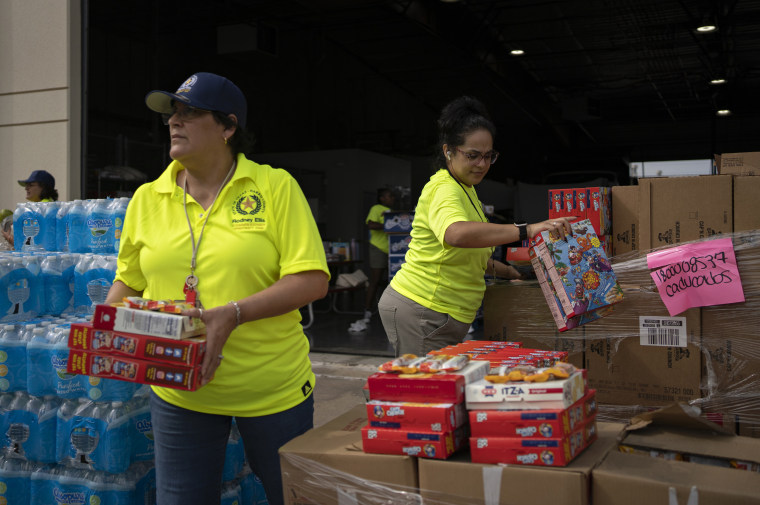When Hurricane Beryl tore through Houston this week, it knocked out power to about 2.26 million power customers. Beryl, which struck the Texas coast as a Category 1 hurricane Monday morning, was the third major storm to strike the nation’s fourth largest city in less than two months. To our knowledge, that’s unprecedented and is a reminder that climate change can rear its ugly head by intensifying storms in unforgiving ways.
Beryl, which struck the Texas coast as a Category 1 hurricane Monday morning, was the third major storm to strike the nation’s fourth largest city in less than two months. To our knowledge, that’s unprecedented.
On May 16 and 17, a derecho with straight-line winds of 100 mph hit Houston with little notice. It blew out thousands of windows in downtown skyscrapers, killed eight people and toppled transmission towers, cutting off power to almost 1 million customers. Before May ended, a destructive storm knocked out the power for 325,000 customers (By our calculations, that’s about 875,000 people.) Though power was restored quickly in both cases, two powerful storms in quick succession left the system battered and weakened.
Add in the fact that it’s been a relatively wet year. The soft soil makes it easier for trees and poles to fall over when the wind blows. Oftentimes repair crews will make temporary fixes to quickly restore power with plans for permanent repairs to follow. In this case, it is unlikely that all repairs from the previous two storms were complete.
Then Beryl struck.
 Cars navigate in the dark as many streetlights are still without power on Thursday in Houston.Danielle Villasana / Getty Images
Cars navigate in the dark as many streetlights are still without power on Thursday in Houston.Danielle Villasana / Getty Images
It’s always dramatic, dangerous and damaging when a hurricane strikes a major city. Houston is no stranger to hurricanes. But they don’t usually strike this powerfully this early in the season, and never before has a hurricane struck so quickly on the heels of two other significant storms.
The aftermath is a crisis. Losing power briefly is inconvenient, uncomfortable and disruptive to the economy. But going without power for multiple days during a heat wave can be downright deadly. The total toll in lives and dollars is huge.
It’s clear now: The weather has changed, but the power grid has not.
So, what can innovators, markets, utilities, cities, states and the federal government do to prepare for and recover from storms?
It’s clear now: The weather has changed, but the power grid has not.
The first thing we need to realize is that for the most part we designed and built our grid decades ago, when the weather was milder. This quick succession of three major storms followed by a heat wave is unprecedented but could be a preview of the future. The stakes are high, and there are solutions at hand we can implement.
So what steps can we take to better our chances for the next storm?
The first step after a crisis is acceptance. We need to understand that storms like these can happen and are going to happen more often. The Gulf of Mexico is getting warmer with climate change, and warmer oceans are more fuel for hurricanes. Hurricane Beryl set multiple records, including as the only Atlantic Category 4 storm to form in June and the strongest July hurricane we’ve ever seen.
 Volunteers and staff of Harris County Precinct 1 give out donated items, including water, sanitary wipes and emergency meals, at its Central Service Center in Houston on Thursday.Danielle Villasana / Getty Images
Volunteers and staff of Harris County Precinct 1 give out donated items, including water, sanitary wipes and emergency meals, at its Central Service Center in Houston on Thursday.Danielle Villasana / Getty Images
We need better communications with those affected by storms. In our modern world, we have come to expect prompt and near constant lines of communication, especially in times like these. Utility outage maps were down even before the storm hit, leaving people to rely on the Whataburger store app to know which parts of the city had power. Though people only use outage tracker maps in rare instances, when they need them, they really need them to be robust.
We need to spend the effort to better model the impacts of storms on the electricity sector. Utilities in the paths of storms should be modeling thousands of future hurricanes and their impacts on the electricity sector. Finding where these storms have common areas of damage overlap and focusing grid hardening efforts in those areas could reduce the impacts for when those storms eventually do hit.
The vast majority of the time, customers lose power because of damage to the distribution system, the small wires and poles that take power the last mile to your home or business. These parts of our infrastructure are the most visible and sometimes are left more vulnerable by our own well-meaning actions, such as pushing back against tree trimming efforts by local utilities.
Though people only use outage tracker maps in rare instances, when they need them, they really need them to be robust.
While it is often more expensive up front, we need to consider putting more of our electricity infrastructure underground and installing stronger poles, such as those made of concrete, steel or composites, in critical areas where older, fragile wooden poles are waiting to fail.
Even with our best efforts, we will not be able to guarantee that the system will be invulnerable against anything thrown at it by nature or humans. We should be looking into strategically deploying energy storage, solar and microgrids (smaller electricity systems that can provide local power when the big grid is down) to particularly risky or important areas. Though much of the electricity system was still down after Beryl, the sun was back up the next day, and the same sun that is making the conditions unbearable could be used to make electricity where it is needed, as long as that infrastructure to store and use it were also hardened to the storm.
Building more efficient homes means they will stay at a more comfortable and safe temperature for longer after the power goes out. And we need to make sure that there are plenty of places where those without power can access safe community cooling centers. For instance: schools with solar panels that can host those without power and provide a safe and healthy place for families to wait for the power to be restored.
In the end, we have to decide resilience is worth the investment. Regulators and rate payers often balk when rates go up to invest in a better system. So, we usually don’t spend the money and we stick with a fragile system that can fail. However, it would be cheaper and more equitable to pay for a better system that stands up more robustly against powerful weather. It feels more expensive up front, but it saves money in the spared lives and in the outages and damages that are avoided. Saving money up front feels prudent, but it’s costly when the system fails to withstand the storm.
Ultimately, intensifying weather is a threat to the power system and modern society, but we have solutions. We should implement them.
Michael E. Webber
Michael E. Webber is the John J. McKetta Centennial Energy Chair in the department of mechanical engineering at the University of Texas at Austin and CTO of Energy Impact Partners, a $3 billion cleantech venture fund. Webber’s expertise spans research and education at the convergence of engineering, policy, and commercialization on topics related to innovation, energy, and the environment.
Joshua D. Rhodes
Joshua D. Rhodes, Ph.D. is a research scientist at The University of Texas at Austin, a non-resident fellow at Columbia University and a founding partner and the CTO of IdeaSmiths LLC. His current work is in the area of smart grid and the bulk electricity system, including spatial system-level applications and impacts of energy efficiency, resource planning, distributed generation, and storage.
>>> Read full article>>>
Copyright for syndicated content belongs to the linked Source : MSNBC – https://www.msnbc.com/opinion/msnbc-opinion/hurricane-beryl-power-outages-houston-tracker-maps-rcna161474































